道康宁产品介绍-2
- 格式:pdf
- 大小:52.57 KB
- 文档页数:10
道康宁产品应用技术手册道康宁产品应用技术手册第一章:产品概述1.1 产品介绍道康宁公司是一家专注于生物医药领域的企业,致力于开发高质量的产品,满足客户的需求。
本手册旨在向用户提供详尽的道康宁产品的应用技术信息,帮助用户正确并更有效地使用这些产品。
1.2 产品分类本章节介绍道康宁产品按照不同分类标准进行了分组,并详细说明了每个产品类别的特点和应用领域。
第二章:产品选择指南2.1 产品特点本节对道康宁产品的特点进行了介绍,包括产品的性能参数、稳定性、适用范围等方面的信息,帮助用户了解产品的优势和适用性。
2.2 产品选择流程根据用户的实际需求,本节提供了一个产品选择的流程图,并详细解释了每一步骤的内容和操作要点,以帮助用户快速选择合适的产品。
第三章:产品操作指南3.1 实验前准备本节介绍了使用道康宁产品前的实验室准备工作,包括实验站位、试剂准备、设备和仪器的校验等方面。
3.2 实验步骤本节对使用道康宁产品的实验步骤进行了详细说明,包括试剂的配制、实验操作顺序和注意事项等。
同时,提供了示意图和实验数据记录表格,以便用户更好地开展实验工作。
第四章:常见问题解答4.1 产品使用中的常见问题本节了用户在使用道康宁产品过程中可能遇到的常见问题,并提供了详细的解答和解决方案,帮助用户解决实验中的困扰。
4.2 技术支持联系方式本节提供了道康宁公司技术支持团队的联系方式,用户如有任何疑问或需要帮助,可以及时与我们联系。
第五章:附件第六章:法律名词及注释6.1 法律名词解释本节列出了文档中使用的一些法律名词并进行了解释,帮助读者清晰理解相应的内容。
6.2 注释说明本节提供了一些文档中使用的专业术语的注释说明,以便读者更好地理解相关概念和内容。
本文档涉及附件:1、产品选择流程图2、实验数据记录表格3、示例图像本文所涉及的法律名词及注释:1、产品认证:指产品通过特定标准的检验和认证机构的认可,符合相应的质量和安全要求。
2、合规性:指在法律法规、技术规范等方面符合要求或要求的程度。
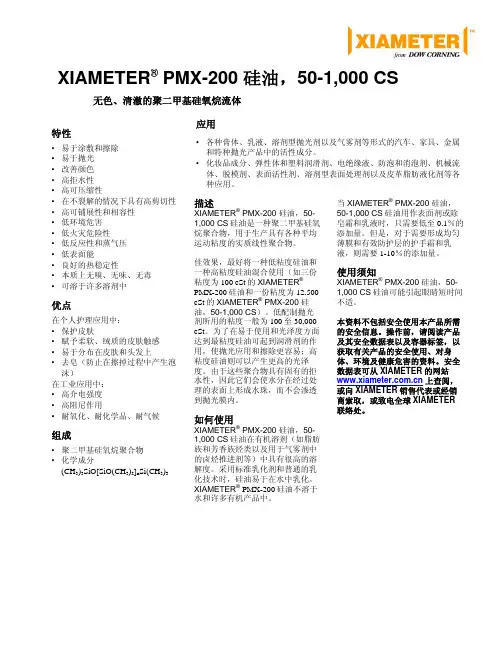
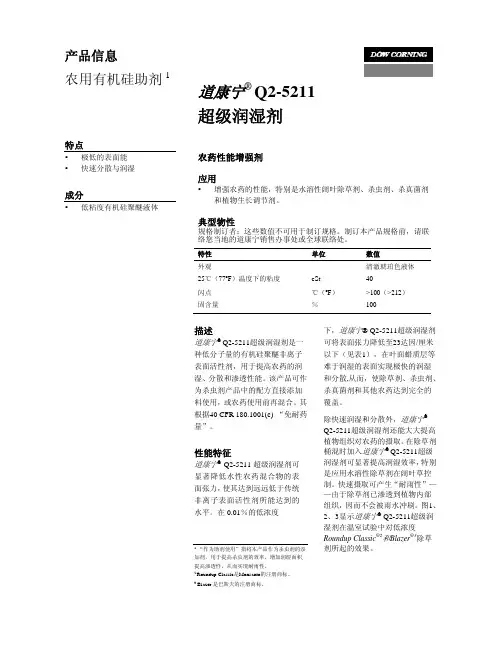

道康宁D321R喷剂
北京瑞德佑业I8OOII3O8I2 王女士
摩力克D321R D321R二硫化钼喷剂D321R价格
MOLYKOTE D321R干式二硫化钼喷剂,包装为400ml,适用于汽缸螺栓,烤箱导轨,汽车后视镜转动机械,高压开关及高负载齿轮,风能机头等设备润滑。
室温快干型,防爬行,具有极佳的粘附性
典型应用汽缸盖螺柱,烘箱导轨、汽车镜,重裁齿轮的磨合、装配用涂层性能
----室温固化快干型、使用方便
----极佳的粘附性、亦可用于光滑表面
----摩擦系数低
----防止爬行
----工作温度范围宽
物理/化学数据
颜色灰黑色
组份固体润滑剂、粘结剂、溶剂
工作温度,℃ -180~+450
闪点,ISO1523,℃ 23
固化时间,min/℃ 5/20
Falex承压试验ASTM-D-2625,N b=4500,p=12500,s=6800
LEW-1,ASTM-D-2714,旋转,n=72
min-1,V=7.9m/min,转数×1000 b=212,p=146,s=306(2860N。
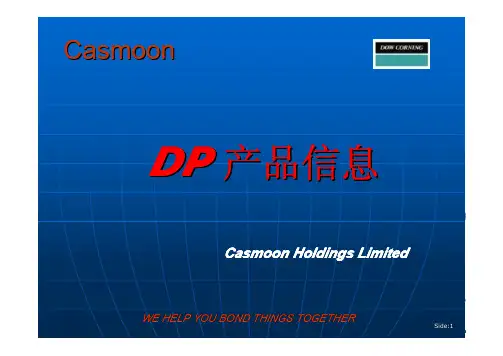
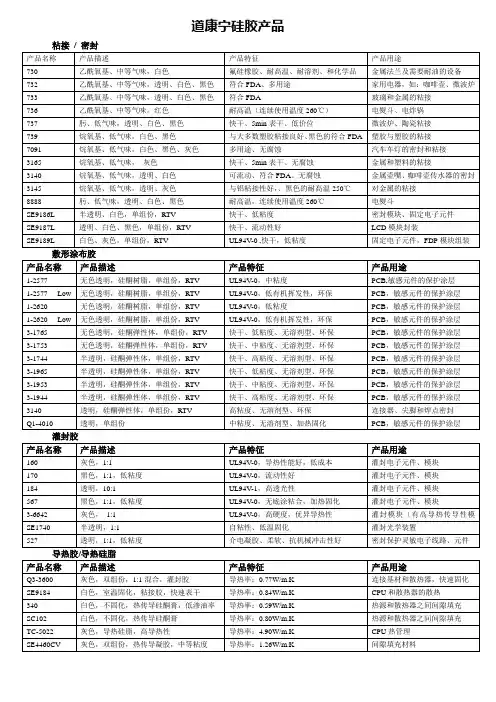
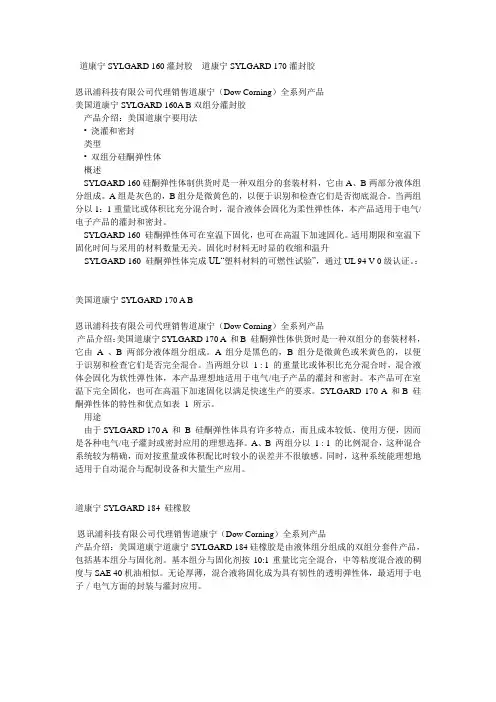
道康宁SYLGARD 160灌封胶道康宁SYLGARD 170灌封胶恩讯浦科技有限公司代理销售道康宁(Dow Corning)全系列产品美国道康宁SYLGARD 160A B双组分灌封胶产品介绍:美国道康宁要用法• 浇灌和密封类型• 双组分硅酮弹性体概述SYLGARD 160硅酮弹性体制供货时是一种双组分的套装材料,它由A、B两部分液体组分组成。
A组是灰色的,B组分是微黄色的,以便于识别和检查它们是否彻底混合。
当两组分以1:1重量比或体积比充分混合时,混合液体会固化为柔性弹性体,本产品适用于电气/电子产品的灌封和密封。
SYLGARD 160 硅酮弹性体可在室温下固化,也可在高温下加速固化。
适用期限和室温下固化时间与采用的材料数量无关。
固化时材料无时显的收缩和温升SYLGARD 160 硅酮弹性体完成UL“塑料材料的可燃性试验”,通过UL 94 V-0级认证。
:美国道康宁SYLGARD 170 A B恩讯浦科技有限公司代理销售道康宁(Dow Corning)全系列产品产品介绍:美国道康宁SYLGARD 170 A 和B 硅酮弹性体供货时是一种双组分的套装材料,它由 A 、B 两部分液体组分组成。
A 组分是黑色的,B 组分是微黄色或米黄色的,以便于识别和检查它们是否完全混合。
当两组分以1 : 1 的重量比或体积比充分混合时,混合液体会固化为软性弹性体,本产品理想地适用于电气/电子产品的灌封和密封。
本产品可在室温下完全固化,也可在高温下加速固化以满足快速生产的要求。
SYLGARD 170 A 和B 硅酮弹性体的特性和优点如表 1 所示。
用途由于SYLGARD 170 A 和B 硅酮弹性体具有许多特点,而且成本较低、使用方便,因而是各种电气/电子灌封或密封应用的理想选择。
A、B 两组分以1 : 1 的比例混合,这种混合系统较为精确,而对按重量或体积配比时较小的误差并不很敏感。
同时,这种系统能理想地适用于自动混合与配制设备和大量生产应用。
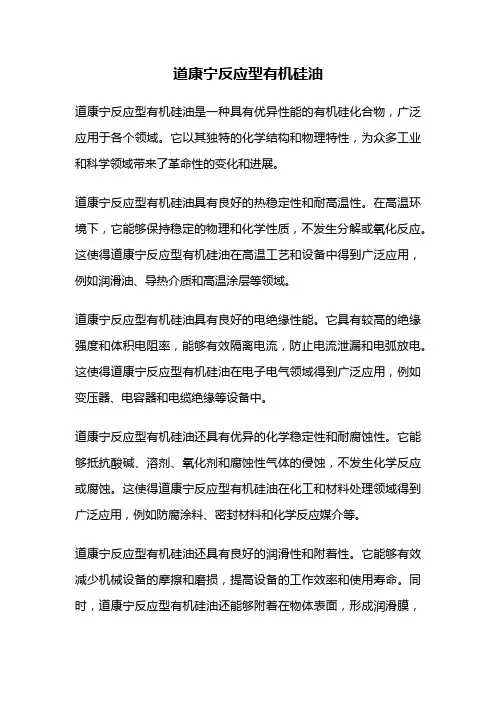
道康宁反应型有机硅油道康宁反应型有机硅油是一种具有优异性能的有机硅化合物,广泛应用于各个领域。
它以其独特的化学结构和物理特性,为众多工业和科学领域带来了革命性的变化和进展。
道康宁反应型有机硅油具有良好的热稳定性和耐高温性。
在高温环境下,它能够保持稳定的物理和化学性质,不发生分解或氧化反应。
这使得道康宁反应型有机硅油在高温工艺和设备中得到广泛应用,例如润滑油、导热介质和高温涂层等领域。
道康宁反应型有机硅油具有良好的电绝缘性能。
它具有较高的绝缘强度和体积电阻率,能够有效隔离电流,防止电流泄漏和电弧放电。
这使得道康宁反应型有机硅油在电子电气领域得到广泛应用,例如变压器、电容器和电缆绝缘等设备中。
道康宁反应型有机硅油还具有优异的化学稳定性和耐腐蚀性。
它能够抵抗酸碱、溶剂、氧化剂和腐蚀性气体的侵蚀,不发生化学反应或腐蚀。
这使得道康宁反应型有机硅油在化工和材料处理领域得到广泛应用,例如防腐涂料、密封材料和化学反应媒介等。
道康宁反应型有机硅油还具有良好的润滑性和附着性。
它能够有效减少机械设备的摩擦和磨损,提高设备的工作效率和使用寿命。
同时,道康宁反应型有机硅油还能够附着在物体表面,形成润滑膜,保护材料不受磨损和腐蚀。
这使得道康宁反应型有机硅油在机械制造和润滑领域得到广泛应用,例如汽车发动机油、润滑脂和润滑油等。
道康宁反应型有机硅油还具有良好的抗氧化性和抗老化性。
在长时间的使用和暴露于外界环境的情况下,它能够保持稳定的物理和化学性质,不发生氧化或降解。
这使得道康宁反应型有机硅油在化妆品、医药和食品工业中得到广泛应用,例如护肤品、药物载体和食品添加剂等。
道康宁反应型有机硅油以其独特的性能和广泛的应用领域,为各个行业带来了巨大的发展机遇和创新空间。
它不仅提升了产品的性能和品质,还推动了工业和科学技术的进步与发展。
随着科学技术的不断发展,道康宁反应型有机硅油将继续发挥重要作用,为人类创造更加美好的生活和未来。
dowsil
DOWSIL有多个同名品牌,其中一个为陶氏公司旗下子品牌,原名为道康宁,2018年2月更名为陶熙。
DOWSIL旗下部分产品介绍如下:
- DOWSIL 3901液体光泽混合物:可用于创造高端护肤品,增强感官体验,帮助消费者释放压力,尽享身心愉悦。
- DOWSIL EL-7040水性弹性体混合物:具有水分散成分,可用来扩展和打造差异化产品。
- DOWSIL 7091密封胶:一款非常出名的RTV硅胶密封胶产品,颜色有黑、白、灰三种,高粘度,固化速度中等,价格便宜,可用于金属、塑胶件密封粘接,在产品外壳上点胶形成密封圈,元器件固定粘接等。
如需了解更多关于DOWSIL的内容,可以继续向我提问。
Page: 1 of 10Version: 3.1Revision Date: 2013/08/19DOW CORNING(R) 7657 ADHESIVE1. PRODUCT AND COMPANY IDENTIFICATIONDow Corning Corporation South Saginaw Road Midland, Michigan 48686 24 Hour Emergency Telephone:Customer Service:Product Disposal Information:CHEMTREC:(989) 496-5900(989) 496-6000(989) 496-6315(800) 424-9300MSDS No.: 02646731 Revision Date: 2013/08/19 Generic Description: Silicone in solventPhysical Form: LiquidColor: ColorlessOdor: Solvent odor.NFPA Profile: Health2Flammability3Instability/Reactivity0Note: NFPA = National Fire Protection Association2. HAZARDS IDENTIFICATIONPOTENTIAL HEALTH EFFECTSAcute EffectsEye: Direct contact may cause mild irritation. Vapor may cause eye irritation.Skin: May cause severe irritation.Inhalation: Vapor may irritate nose and throat. Overexposure by inhalation may cause drowsiness,dizziness, confusion or loss of coordination.Oral: Low ingestion hazard in normal use.Prolonged/Repeated Exposure EffectsSkin: Repeated or prolonged contact may cause defatting and drying of skin which may result inskin irritation and dermatitis.Inhalation: Overexposure by inhalation may injure the following organ(s): Liver. Kidneys. Nervoussystem.Oral: No known applicable information.Other Health EffectsThis product contains a chemical(s) that has the following effect(s):Developmental ToxicityCarcinogenicityPage: 2 of 10Version: 3.1Revision Date: 2013/08/19DOW CORNING(R) 7657 ADHESIVESee Section 11 for specific details.Signs and Symptoms of OverexposureNo known applicable information.Medical Conditions Aggravated by ExposureNo known applicable information.The above listed potential effects of overexposure are based on actual data, results of studies performed upon similar compositions, component data and/or expert review of the product. Please refer to Section 11 for the detailed toxicology information.3. COMPOSITION/INFORMATION ON INGREDIENTSNameCAS Number Wt% Component1330-20-7 30.0 - 50.0 Xylene100-41-4 7.0 - 13.0 Ethylbenzene3555-47-3 1.0 - 5.0 Tetra(trimethylsiloxy) silane<1.0 Toluene108-88-363148-57-2 <1.0 Methylhydrogen Siloxane, Trimethylsiloxy-terminatedThe above components are hazardous as defined in 29 CFR 1910.1200.4. FIRST AID MEASURESEye: Remove from the source of contamination or move to fresh air Immediately flush thecontaminated eye(s) with lukewarm, gently flowing water for 5 minutes while holding theeyelid(s) open. Obtain medical attention.Skin: As quickly as possible remove contaminated clothing, shoes and leather goods (e.g.watchbands, belts). Quickly and gently blot or brush away excess chemical. Immediatelyflush with lukewarm gently flowing water for 15 minutes. Completely decontaminate clothing,shoes and leather goods before reuse or discard. Immediately obtain medical attention. Inhalation: Remove from the source of contamination or move to fresh air. Obtain medical attention. Oral: If irritation or discomfort occur, obtain medical advice.Notes to Physician: Treat according to person's condition and specifics of exposure.Page: 3 of 10Version: 3.1Revision Date: 2013/08/19DOW CORNING(R) 7657 ADHESIVE5. FIRE FIGHTING MEASURESFlash Point: 73.4 °F / 23 °C (Pensky-Martens Closed Cup)Autoignition Temperature: Not determined.Flammability Limits in Air: Not determined.Extinguishing Media: On large fires use AFFF alcohol compatible foam or water spray (fog). On small fires useAFFF alcohol compatible foam, CO2 or water spray (fog). Water can be used to cool fireexposed containers. Do not allow extinguishing medium to contact container contents. Mostfire extinguishing media will cause hydrogen evolution. When the fire is put out, hydrogenmay accumulate in poorly ventilated or confined areas and result in flash fire or explosion ifignited. Foam blankets may also trap hydrogen or flammable vapors, with the possibility ofsubsurface explosion.Dry chemical.Unsuitable ExtinguishingMedia:Fire Fighting Measures: Self-contained breathing apparatus and protective clothing should be worn in fighting largefires involving chemicals. Determine the need to evacuate or isolate the area according toyour local emergency plan. Use water spray to keep fire exposed containers cool.Unusual Fire Hazards: Vapors are heavier than air and may travel to a source of ignition and flash back. Staticelectricity will accumulate and may ignite vapors. Prevent a possible fire hazard by bondingand grounding or inert gas purge.6. ACCIDENTAL RELEASE MEASURESContainment/Clean up: Remove possible ignition sources. Determine whether to evacuate or isolate the areaaccording to your local emergency plan. Observe all personal protection equipmentrecommendations described in Sections 5 and 8. For large spills, provide diking or otherappropriate containment to keep material from spreading. If diked material can be pumped,store recovered material in appropriate container. Materials in contact with water, moisture,acids or bases have the potential to generate hydrogen gas. Recovered material should bestored in a vented container. Clean up remaining materials from spill with suitable absorbant.Clean area as appropriate since spilled materials, even in small quantities, may present a sliphazard. Final cleaning may require use of steam, solvents or detergents. Dispose ofsaturated absorbant or cleaning materials appropriately, since spontaneous heating mayoccur. Local, state and federal laws and regulations may apply to releases and disposal ofthis material, as well as those materials and items employed in the cleanup of releases. Youwill need to determine which federal, state and local laws and regulations are applicable.Sections 13 and 15 of this MSDS provide information regarding certain federal and staterequirements.Note: See Section 8 for Personal Protective Equipment for Spills. Call (989) 496-5900, if additional information is required.Page: 4 of 10Version: 3.1Revision Date: 2013/08/19DOW CORNING(R) 7657 ADHESIVE7. HANDLING AND STORAGEUse with adequate ventilation. Avoid eye exposure. Do not get on skin. Avoid breathing vapor, mist, dust, or fumes. Keep container closed.Static electricity will accumulate and may ignite vapors. Prevent a possible fire hazard by bonding and grounding or inert gas purge. Keep container closed and away from heat, sparks, and flame. Product may evolve minute quantities of flammable hydrogen gas which can accumulate. Adequately ventilate to maintain vapors well below flammability limits and exposure guidelines. Do not repackage. Do not store in glass containers which may shatter due to pressure build up. Clogged container vents may increase pressure build up. Keep container closed and store away from water or moisture.8. EXPOSURE CONTROLS / PERSONAL PROTECTIONComponent Exposure LimitsName Exposure LimitsCAS Number Component1330-20-7 Xylene Observe xylene limits. OSHA PEL (final rule) and ACGIHTLV: TWA 100 ppm, STEL 150 ppm.100-41-4 Ethylbenzene OSHA PEL (final rule): TWA 100 ppm, 435 mg/m3. ACGIHTLV: TWA 20 ppm, STEL 125 ppm.Engineering ControlsLocal Ventilation: Recommended.General Ventilation: Recommended.Personal Protective Equipment for Routine HandlingEyes: Use chemical worker's goggles.Skin: Wash at mealtime and end of shift. Skin contact must be avoided by using imperviousprotective clothing (gloves, aprons, boots, etc.). Use chemical protective gloves as aminimum and wash skin promptly upon any skin contact.Suitable Gloves: Avoid skin contact by implementing good industrial hygiene practices and procedures. Select and use gloves and/or protective clothing to further minimize the potential for skin contact.Consult with your glove and/or personnel protective equipment manufacturer for selection ofappropriate compatible materials.Inhalation: Use respiratory protection unless adequate local exhaust ventilation is provided or exposure assessment demonstrates that exposures are within recommended exposure guidelines. IHpersonnel can assist in judging the adequacy of existing engineering controls.Page: 5 of 10Version: 3.1Revision Date: 2013/08/19DOW CORNING(R) 7657 ADHESIVESuitable Respirator: General and local exhaust ventilation is recommended to maintain vapor exposures belowrecommended limits. Where concentrations are above recommended limits or are unknown,appropriate respiratory protection should be worn. Follow OSHA respirator regulations (29CFR 1910.134) and use NIOSH/MSHA approved respirators.Personal Protective Equipment for SpillsEyes: Use full face respirator.Skin: Wash at mealtime and end of shift. Skin contact must be avoided by using imperviousprotective clothing (gloves, aprons, boots, etc.). Use chemical protective gloves as aminimum and wash skin promptly upon any skin contact.Inhalation/Suitable Respirator: Respiratory protection recommended. Follow OSHA Respirator Regulations (29 CFR 1910.134) and use NIOSH/MHSA approved respirators. Protection provided by air purifying respirators against exposure to any hazardous chemical is limited. Use a positive pressure air supplied respirator if there is any potential for uncontrolled release, exposure levels are unknown, or any other circumstance where air purifying respirators may not provide adequate protection.Precautionary Measures: Avoid eye exposure. Do not get on skin. Avoid breathing vapor, mist, dust, or fumes. Keep container closed. Use reasonable care.Note: These precautions are for room temperature handling. Use at elevated temperature or aerosol/spray applications may require added precautions. For further information regarding aerosol inhalation toxicity, please refer to the guidance document regarding the use of silicone-based materials in aerosol applications that has been developed by the silicone industry () or contact the Dow Corning customer service group.9. PHYSICAL AND CHEMICAL PROPERTIESPhysical Form: LiquidColor: ColorlessOdor: Solvent odor.Specific Gravity @ 25°C: 1Viscosity: 40000 cStFreezing/Melting Point: Not determined.Boiling Point: > 100 °CVapor Pressure @ 25°C: Not determined.Vapor Density: Not determined.Solubility in Water: Not determined.pH: Not determined.Volatile Content: 56 %Flash Point: 73.4 °F / 23 °C (Pensky-Martens Closed Cup)Autoignition Temperature: Not determined.Flammability Limits in Air: Not determined.Note: The above information is not intended for use in preparing product specifications. Contact Dow Corning before writing specifications.Page: 6 of 10Version: 3.1Revision Date: 2013/08/19DOW CORNING(R) 7657 ADHESIVE10. STABILITY AND REACTIVITYChemical Stability: Stable.Hazardous polymerization will not occur.HazardousPolymerization:Conditions to Avoid: None.Materials to Avoid: Oxidizing material can cause a reaction. Water, alcohols, acidic or basic materials, and many metals or metallic compounds, when in contact with product, liberate flammable hydrogengas, which can form explosive mixtures in air.Hazardous Decomposition ProductsThermal breakdown of this product during fire or very high heat conditions may evolve the following decomposition products: Carbon oxides and traces of incompletely burned carbon compounds. Silicon dioxide. Formaldehyde. Hydrogen.11. TOXICOLOGICAL INFORMATIONSpecial Hazard Information on ComponentsCarcinogensCAS Number Wt % Component Name100-41-4 7.0 - 13.0 Ethylbenzene IARC Group 2B - Possibly Carcinogenicto Humans.Developmental ToxicityCAS Number Wt % Component Name1330-20-7 30.0 - 50.0 Xylene12. ECOLOGICAL INFORMATIONEnvironmental Fate and DistributionComplete information is not yet available.Environmental EffectsComplete information is not yet available.Page: 7 of 10Version: 3.1Revision Date: 2013/08/19DOW CORNING(R) 7657 ADHESIVEFate and Effects in Waste Water Treatment PlantsComplete information is not yet available.Ecotoxicity Classification CriteriaHazard Parameters (LC50 or EC50) High Medium LowAcute Aquatic Toxicity (mg/L) <=1 >1 and <=100 >100Acute Terrestrial Toxicity <=100 >100 and <= 2000 >2000This table is adapted from "Environmental Toxicology and Risk Assessment", ASTM STP 1179, p.34, 1993.This table can be used to classify the ecotoxicity of this product when ecotoxicity data is listed above. Please read the other information presented in the section concerning the overall ecological safety of this material.13. DISPOSAL CONSIDERATIONSRCRA Hazard Class (40 CFR 261)When a decision is made to discard this material, as received, is it classified as a hazardous waste? Yes Characteristic Waste:Ignitable: D001Reactive: D003TCLP: D018State or local laws may impose additional regulatory requirements regarding disposal. Call (989) 496-6315, if additional information is required.14. TRANSPORT INFORMATIONDOT Road Shipment Information (49 CFR 172.101)Proper Shipping Name: AdhesivesHazard Class: 3UN/NA Number: UN 1133Packing Group: IIIHazard Label(s): Flammable LiquidOcean Shipment (IMDG)Proper Shipping Name: ADHESIVESPage: 8 of 10Version: 3.1Revision Date: 2013/08/19DOW CORNING(R) 7657 ADHESIVEHazard Class: 3UN/NA Number: UN 1133Packing Group: IIIHazard Label(s): flammable liquidAir Shipment (IATA)Proper Shipping Name: AdhesivesHazard Class: 3UN/NA Number: UN 1133Packing Group: IIIHazard Label(s): Flammable LiquidCall Dow Corning Transportation, (989) 496-8577, if additional information is required.15. REGULATORY INFORMATIONContents of this MSDS comply with the OSHA Hazard Communication Standard 29 CFR 1910.1200.TSCA Status: All chemical substances in this material are included on or exempted from listing on the TSCA Inventory of Chemical Substances.EPA SARA Title III Chemical ListingsSection 302 Extremely Hazardous Substances (40 CFR 355):None.Section 304 CERCLA Hazardous Substances (40 CFR 302):CAS Number Wt % Component Name1330-20-7 35.0 Xylene100-41-4 10.0 Ethylbenzene108-88-3 0.24 Toluene71-43-2 <0.1 BenzeneSection 311/312 Hazard Class (40 CFR 370):Acute: YesPage: 9 of 10Version: 3.1Revision Date: 2013/08/19DOW CORNING(R) 7657 ADHESIVEChronic: YesFire: YesPressure: NoReactive: YesSection 313 Toxic Chemicals (40 CFR 372):CAS Number Wt % Component Name1330-20-7 35.0 Xylene100-41-4 10.0 EthylbenzeneNote: Chemicals are listed under the 313 Toxic Chemicals section only if they meet or exceed a reporting threshold. Supplemental State Compliance InformationCaliforniaWarning: This product contains the following chemical(s) listed by the State of California under the Safe Drinking Water and Toxic Enforcement Act of 1986 (Proposition 65) as being known to cause cancer, birth defects or other reproductive harm.CAS Number Wt % Component NameEthylbenzene Carcinogenic.100-41-4 7.0000 -13.0000<1.0000 Toluene Developmental toxin.108-88-3<0.0100 Benzene71-43-2Developmental toxin.Male reproductive toxin.New JerseyCAS Number Wt % Component Name1330-20-7 30.0 - 50.0 Xylene68988-56-7 30.0 - 50.0 Trimethylated silica68083-19-2 15.0 - 35.0 Dimethyl siloxane, dimethylvinyl-terminated100-41-4 7.0 - 13.0 Ethylbenzene3555-47-3 1.0 - 5.0 Tetra(trimethylsiloxy) silanePage: 10 of 10Version: 3.1Revision Date: 2013/08/19DOW CORNING(R) 7657 ADHESIVEPennsylvaniaCAS Number Wt % Component Name1330-20-7 30.0 - 50.0 Xylene68988-56-7 30.0 - 50.0 Trimethylated silica68083-19-2 15.0 - 35.0 Dimethyl siloxane, dimethylvinyl-terminated100-41-4 7.0 - 13.0 Ethylbenzene<0.1 Benzene71-43-216. OTHER INFORMATIONPrepared by: Dow Corning CorporationThese data are offered in good faith as typical values and not as product specifications. No warranty, either expressed or implied, is hereby made. The recommended industrial hygiene and safe handling procedures are believed to be generally applicable. However, each user should review these recommendations in the specific context of the intended use and determine whether they are appropriate.(R) indicates Registered Trademark。
东莞胜威化工代理道康宁,信越产品。
Dowcorning 道康宁1-2620敷形涂Array料产品介绍道康宁1-2620为单组分、透明、低粘度敷形涂料,固化后具有坚固的、耐磨损的表面。
固化后形成柔韧的、弹性的、耐磨的表面;溶剂基树脂涂层;室温固化,亦可选择在溶剂闪蒸后加热以加速固化;含UV指示剂;ULV-0阻燃性等级;通过Mil Spec 46058C试验。
道康宁1-2620主要用途可用于刚性和柔性电路板的保护涂料。
这种快速固化、单组份、自粘性涂料,固化后形成柔韧的透明的弹塑性涂料,是印刷线路板使用的理想材料,尤其是要求坚韧和抗磨损的线路板。
Dowcorning 1-2620使用方法通过喷涂、刷涂、流动、浸渍或自动化选择性方法涂覆。
对于喷涂法建议溶剂稀释到最多不超过60%。
对于浸渍涂法,材料可以即时使用,或以溶剂稀释以便得到更薄的涂层。
应当注意确保溶剂避免受潮,浸渍槽不使用时要封盖。
在稀释低挥发性有机物含量的涂料时,推荐使用道康宁? OS-20 硅油。
道康宁1-2620固化方法可以用加热的方法来缩短达到表干所需的时间。
当使用加热方法时,要有充分间先让溶剂挥发,然后再放入热风循环型烘箱中加热。
通常3密尔(75微米)涂层的固化时间是先在室温下放置10分钟,然后再在80°C 温度下放置10分钟。
如果涂层起泡,或者含有汽泡,应在室温下放置更长的时间,让溶剂挥发掉之后,放入烘箱中固化。
一般特性:可固化涂层、气味少、溶剂型、热固化产品使用特性:单组分固化特性:甲氧基固化、脱醇固化热性质:低温稳定性、高温稳定性相容性:塑料、聚酯、陶瓷稳定性:抗氧化、耐水的、耐热性、耐磨损性、耐臭氧性、防紫外辐射粘接性:与FR4、塑料、金属、铝、陶瓷、无底漆粘接性道康宁1-2620使用温度范围对于大多数用途,有机硅弹性体可以在-45至200°C (-49至392°F)的温度范围内长期使用。
然而在温度范围的上下限,在特殊应用时材料的特性和表现可能变得复杂化,需要额外考虑。
Page: 1 of 10Version: 3.1Revision Date: 2013/08/19DOW CORNING(R) 7657 ADHESIVE1. PRODUCT AND COMPANY IDENTIFICATIONDow Corning Corporation South Saginaw Road Midland, Michigan 48686 24 Hour Emergency Telephone:Customer Service:Product Disposal Information:CHEMTREC:(989) 496-5900(989) 496-6000(989) 496-6315(800) 424-9300MSDS No.: 02646731 Revision Date: 2013/08/19 Generic Description: Silicone in solventPhysical Form: LiquidColor: ColorlessOdor: Solvent odor.NFPA Profile: Health2Flammability3Instability/Reactivity0Note: NFPA = National Fire Protection Association2. HAZARDS IDENTIFICATIONPOTENTIAL HEALTH EFFECTSAcute EffectsEye: Direct contact may cause mild irritation. Vapor may cause eye irritation.Skin: May cause severe irritation.Inhalation: Vapor may irritate nose and throat. Overexposure by inhalation may cause drowsiness,dizziness, confusion or loss of coordination.Oral: Low ingestion hazard in normal use.Prolonged/Repeated Exposure EffectsSkin: Repeated or prolonged contact may cause defatting and drying of skin which may result inskin irritation and dermatitis.Inhalation: Overexposure by inhalation may injure the following organ(s): Liver. Kidneys. Nervoussystem.Oral: No known applicable information.Other Health EffectsThis product contains a chemical(s) that has the following effect(s):Developmental ToxicityCarcinogenicityPage: 2 of 10Version: 3.1Revision Date: 2013/08/19DOW CORNING(R) 7657 ADHESIVESee Section 11 for specific details.Signs and Symptoms of OverexposureNo known applicable information.Medical Conditions Aggravated by ExposureNo known applicable information.The above listed potential effects of overexposure are based on actual data, results of studies performed upon similar compositions, component data and/or expert review of the product. Please refer to Section 11 for the detailed toxicology information.3. COMPOSITION/INFORMATION ON INGREDIENTSNameCAS Number Wt% Component1330-20-7 30.0 - 50.0 Xylene100-41-4 7.0 - 13.0 Ethylbenzene3555-47-3 1.0 - 5.0 Tetra(trimethylsiloxy) silane<1.0 Toluene108-88-363148-57-2 <1.0 Methylhydrogen Siloxane, Trimethylsiloxy-terminatedThe above components are hazardous as defined in 29 CFR 1910.1200.4. FIRST AID MEASURESEye: Remove from the source of contamination or move to fresh air Immediately flush thecontaminated eye(s) with lukewarm, gently flowing water for 5 minutes while holding theeyelid(s) open. Obtain medical attention.Skin: As quickly as possible remove contaminated clothing, shoes and leather goods (e.g.watchbands, belts). Quickly and gently blot or brush away excess chemical. Immediatelyflush with lukewarm gently flowing water for 15 minutes. Completely decontaminate clothing,shoes and leather goods before reuse or discard. Immediately obtain medical attention. Inhalation: Remove from the source of contamination or move to fresh air. Obtain medical attention. Oral: If irritation or discomfort occur, obtain medical advice.Notes to Physician: Treat according to person's condition and specifics of exposure.Page: 3 of 10Version: 3.1Revision Date: 2013/08/19DOW CORNING(R) 7657 ADHESIVE5. FIRE FIGHTING MEASURESFlash Point: 73.4 °F / 23 °C (Pensky-Martens Closed Cup)Autoignition Temperature: Not determined.Flammability Limits in Air: Not determined.Extinguishing Media: On large fires use AFFF alcohol compatible foam or water spray (fog). On small fires useAFFF alcohol compatible foam, CO2 or water spray (fog). Water can be used to cool fireexposed containers. Do not allow extinguishing medium to contact container contents. Mostfire extinguishing media will cause hydrogen evolution. When the fire is put out, hydrogenmay accumulate in poorly ventilated or confined areas and result in flash fire or explosion ifignited. Foam blankets may also trap hydrogen or flammable vapors, with the possibility ofsubsurface explosion.Dry chemical.Unsuitable ExtinguishingMedia:Fire Fighting Measures: Self-contained breathing apparatus and protective clothing should be worn in fighting largefires involving chemicals. Determine the need to evacuate or isolate the area according toyour local emergency plan. Use water spray to keep fire exposed containers cool.Unusual Fire Hazards: Vapors are heavier than air and may travel to a source of ignition and flash back. Staticelectricity will accumulate and may ignite vapors. Prevent a possible fire hazard by bondingand grounding or inert gas purge.6. ACCIDENTAL RELEASE MEASURESContainment/Clean up: Remove possible ignition sources. Determine whether to evacuate or isolate the areaaccording to your local emergency plan. Observe all personal protection equipmentrecommendations described in Sections 5 and 8. For large spills, provide diking or otherappropriate containment to keep material from spreading. If diked material can be pumped,store recovered material in appropriate container. Materials in contact with water, moisture,acids or bases have the potential to generate hydrogen gas. Recovered material should bestored in a vented container. Clean up remaining materials from spill with suitable absorbant.Clean area as appropriate since spilled materials, even in small quantities, may present a sliphazard. Final cleaning may require use of steam, solvents or detergents. Dispose ofsaturated absorbant or cleaning materials appropriately, since spontaneous heating mayoccur. Local, state and federal laws and regulations may apply to releases and disposal ofthis material, as well as those materials and items employed in the cleanup of releases. Youwill need to determine which federal, state and local laws and regulations are applicable.Sections 13 and 15 of this MSDS provide information regarding certain federal and staterequirements.Note: See Section 8 for Personal Protective Equipment for Spills. Call (989) 496-5900, if additional information is required.Page: 4 of 10Version: 3.1Revision Date: 2013/08/19DOW CORNING(R) 7657 ADHESIVE7. HANDLING AND STORAGEUse with adequate ventilation. Avoid eye exposure. Do not get on skin. Avoid breathing vapor, mist, dust, or fumes. Keep container closed.Static electricity will accumulate and may ignite vapors. Prevent a possible fire hazard by bonding and grounding or inert gas purge. Keep container closed and away from heat, sparks, and flame. Product may evolve minute quantities of flammable hydrogen gas which can accumulate. Adequately ventilate to maintain vapors well below flammability limits and exposure guidelines. Do not repackage. Do not store in glass containers which may shatter due to pressure build up. Clogged container vents may increase pressure build up. Keep container closed and store away from water or moisture.8. EXPOSURE CONTROLS / PERSONAL PROTECTIONComponent Exposure LimitsName Exposure LimitsCAS Number Component1330-20-7 Xylene Observe xylene limits. OSHA PEL (final rule) and ACGIHTLV: TWA 100 ppm, STEL 150 ppm.100-41-4 Ethylbenzene OSHA PEL (final rule): TWA 100 ppm, 435 mg/m3. ACGIHTLV: TWA 20 ppm, STEL 125 ppm.Engineering ControlsLocal Ventilation: Recommended.General Ventilation: Recommended.Personal Protective Equipment for Routine HandlingEyes: Use chemical worker's goggles.Skin: Wash at mealtime and end of shift. Skin contact must be avoided by using imperviousprotective clothing (gloves, aprons, boots, etc.). Use chemical protective gloves as aminimum and wash skin promptly upon any skin contact.Suitable Gloves: Avoid skin contact by implementing good industrial hygiene practices and procedures. Select and use gloves and/or protective clothing to further minimize the potential for skin contact.Consult with your glove and/or personnel protective equipment manufacturer for selection ofappropriate compatible materials.Inhalation: Use respiratory protection unless adequate local exhaust ventilation is provided or exposure assessment demonstrates that exposures are within recommended exposure guidelines. IHpersonnel can assist in judging the adequacy of existing engineering controls.Page: 5 of 10Version: 3.1Revision Date: 2013/08/19DOW CORNING(R) 7657 ADHESIVESuitable Respirator: General and local exhaust ventilation is recommended to maintain vapor exposures belowrecommended limits. Where concentrations are above recommended limits or are unknown,appropriate respiratory protection should be worn. Follow OSHA respirator regulations (29CFR 1910.134) and use NIOSH/MSHA approved respirators.Personal Protective Equipment for SpillsEyes: Use full face respirator.Skin: Wash at mealtime and end of shift. Skin contact must be avoided by using imperviousprotective clothing (gloves, aprons, boots, etc.). Use chemical protective gloves as aminimum and wash skin promptly upon any skin contact.Inhalation/Suitable Respirator: Respiratory protection recommended. Follow OSHA Respirator Regulations (29 CFR 1910.134) and use NIOSH/MHSA approved respirators. Protection provided by air purifying respirators against exposure to any hazardous chemical is limited. Use a positive pressure air supplied respirator if there is any potential for uncontrolled release, exposure levels are unknown, or any other circumstance where air purifying respirators may not provide adequate protection.Precautionary Measures: Avoid eye exposure. Do not get on skin. Avoid breathing vapor, mist, dust, or fumes. Keep container closed. Use reasonable care.Note: These precautions are for room temperature handling. Use at elevated temperature or aerosol/spray applications may require added precautions. For further information regarding aerosol inhalation toxicity, please refer to the guidance document regarding the use of silicone-based materials in aerosol applications that has been developed by the silicone industry () or contact the Dow Corning customer service group.9. PHYSICAL AND CHEMICAL PROPERTIESPhysical Form: LiquidColor: ColorlessOdor: Solvent odor.Specific Gravity @ 25°C: 1Viscosity: 40000 cStFreezing/Melting Point: Not determined.Boiling Point: > 100 °CVapor Pressure @ 25°C: Not determined.Vapor Density: Not determined.Solubility in Water: Not determined.pH: Not determined.Volatile Content: 56 %Flash Point: 73.4 °F / 23 °C (Pensky-Martens Closed Cup)Autoignition Temperature: Not determined.Flammability Limits in Air: Not determined.Note: The above information is not intended for use in preparing product specifications. Contact Dow Corning before writing specifications.Page: 6 of 10Version: 3.1Revision Date: 2013/08/19DOW CORNING(R) 7657 ADHESIVE10. STABILITY AND REACTIVITYChemical Stability: Stable.Hazardous polymerization will not occur.HazardousPolymerization:Conditions to Avoid: None.Materials to Avoid: Oxidizing material can cause a reaction. Water, alcohols, acidic or basic materials, and many metals or metallic compounds, when in contact with product, liberate flammable hydrogengas, which can form explosive mixtures in air.Hazardous Decomposition ProductsThermal breakdown of this product during fire or very high heat conditions may evolve the following decomposition products: Carbon oxides and traces of incompletely burned carbon compounds. Silicon dioxide. Formaldehyde. Hydrogen.11. TOXICOLOGICAL INFORMATIONSpecial Hazard Information on ComponentsCarcinogensCAS Number Wt % Component Name100-41-4 7.0 - 13.0 Ethylbenzene IARC Group 2B - Possibly Carcinogenicto Humans.Developmental ToxicityCAS Number Wt % Component Name1330-20-7 30.0 - 50.0 Xylene12. ECOLOGICAL INFORMATIONEnvironmental Fate and DistributionComplete information is not yet available.Environmental EffectsComplete information is not yet available.Page: 7 of 10Version: 3.1Revision Date: 2013/08/19DOW CORNING(R) 7657 ADHESIVEFate and Effects in Waste Water Treatment PlantsComplete information is not yet available.Ecotoxicity Classification CriteriaHazard Parameters (LC50 or EC50) High Medium LowAcute Aquatic Toxicity (mg/L) <=1 >1 and <=100 >100Acute Terrestrial Toxicity <=100 >100 and <= 2000 >2000This table is adapted from "Environmental Toxicology and Risk Assessment", ASTM STP 1179, p.34, 1993.This table can be used to classify the ecotoxicity of this product when ecotoxicity data is listed above. Please read the other information presented in the section concerning the overall ecological safety of this material.13. DISPOSAL CONSIDERATIONSRCRA Hazard Class (40 CFR 261)When a decision is made to discard this material, as received, is it classified as a hazardous waste? Yes Characteristic Waste:Ignitable: D001Reactive: D003TCLP: D018State or local laws may impose additional regulatory requirements regarding disposal. Call (989) 496-6315, if additional information is required.14. TRANSPORT INFORMATIONDOT Road Shipment Information (49 CFR 172.101)Proper Shipping Name: AdhesivesHazard Class: 3UN/NA Number: UN 1133Packing Group: IIIHazard Label(s): Flammable LiquidOcean Shipment (IMDG)Proper Shipping Name: ADHESIVESPage: 8 of 10Version: 3.1Revision Date: 2013/08/19DOW CORNING(R) 7657 ADHESIVEHazard Class: 3UN/NA Number: UN 1133Packing Group: IIIHazard Label(s): flammable liquidAir Shipment (IATA)Proper Shipping Name: AdhesivesHazard Class: 3UN/NA Number: UN 1133Packing Group: IIIHazard Label(s): Flammable LiquidCall Dow Corning Transportation, (989) 496-8577, if additional information is required.15. REGULATORY INFORMATIONContents of this MSDS comply with the OSHA Hazard Communication Standard 29 CFR 1910.1200.TSCA Status: All chemical substances in this material are included on or exempted from listing on the TSCA Inventory of Chemical Substances.EPA SARA Title III Chemical ListingsSection 302 Extremely Hazardous Substances (40 CFR 355):None.Section 304 CERCLA Hazardous Substances (40 CFR 302):CAS Number Wt % Component Name1330-20-7 35.0 Xylene100-41-4 10.0 Ethylbenzene108-88-3 0.24 Toluene71-43-2 <0.1 BenzeneSection 311/312 Hazard Class (40 CFR 370):Acute: YesPage: 9 of 10Version: 3.1Revision Date: 2013/08/19DOW CORNING(R) 7657 ADHESIVEChronic: YesFire: YesPressure: NoReactive: YesSection 313 Toxic Chemicals (40 CFR 372):CAS Number Wt % Component Name1330-20-7 35.0 Xylene100-41-4 10.0 EthylbenzeneNote: Chemicals are listed under the 313 Toxic Chemicals section only if they meet or exceed a reporting threshold. Supplemental State Compliance InformationCaliforniaWarning: This product contains the following chemical(s) listed by the State of California under the Safe Drinking Water and Toxic Enforcement Act of 1986 (Proposition 65) as being known to cause cancer, birth defects or other reproductive harm.CAS Number Wt % Component NameEthylbenzene Carcinogenic.100-41-4 7.0000 -13.0000<1.0000 Toluene Developmental toxin.108-88-3<0.0100 Benzene71-43-2Developmental toxin.Male reproductive toxin.New JerseyCAS Number Wt % Component Name1330-20-7 30.0 - 50.0 Xylene68988-56-7 30.0 - 50.0 Trimethylated silica68083-19-2 15.0 - 35.0 Dimethyl siloxane, dimethylvinyl-terminated100-41-4 7.0 - 13.0 Ethylbenzene3555-47-3 1.0 - 5.0 Tetra(trimethylsiloxy) silanePage: 10 of 10Version: 3.1Revision Date: 2013/08/19DOW CORNING(R) 7657 ADHESIVEPennsylvaniaCAS Number Wt % Component Name1330-20-7 30.0 - 50.0 Xylene68988-56-7 30.0 - 50.0 Trimethylated silica68083-19-2 15.0 - 35.0 Dimethyl siloxane, dimethylvinyl-terminated100-41-4 7.0 - 13.0 Ethylbenzene<0.1 Benzene71-43-216. OTHER INFORMATIONPrepared by: Dow Corning CorporationThese data are offered in good faith as typical values and not as product specifications. No warranty, either expressed or implied, is hereby made. The recommended industrial hygiene and safe handling procedures are believed to be generally applicable. However, each user should review these recommendations in the specific context of the intended use and determine whether they are appropriate.(R) indicates Registered Trademark。